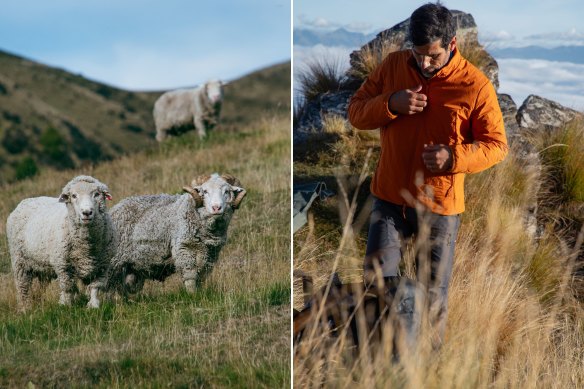[ad_1]

Australian chemist and mountaineer George Finch first made a jacket using goose down.Credit: Wikipedia
Early versions of the jacket more closely resembling today’s styles began to appear in the 1930s, but it was the hip-hop and rap culture of the 1980s and 1990s that precipitated the puffer’s leap into the mainstream.
According to online retailer The Iconic, puffer jackets remain consistently in its top 100 searches – sales are up 30 per cent on last year, according to a spokeswoman – with the most popular brands including Kathmandu and The North Face.
Far from being a garment exclusively designed for the outdoors (as in actual hiking, as opposed to “quiet outdoors” and the “gorpcore” trends) the puffer has also received the luxury treatment from Balenciaga and Moncler, which has worked with houses including Valentino to turn the puffer jacket into haute couture.
Still, despite Vogue Business asserting late last year that the market has reached peak puffer, the global market for coats and jackets remains steady at $79 billion. According to Vogue“those with function, versatility and more sustainable credentials” will win out.
How green is your (black) jacket?
In 2022, outdoor brand Kathmandu released a jacket it marketed as fully biodegradable. But the company was later accused of greenwashing, pulling an advertisement that the Advertising Standards Authority in New Zealand found breached the code. The issue? The jacket could break down in landfill, but only in a precise set of circumstances that are beyond the scope of most public waste-disposal schemes.
Loading
The issue of greenwashing in a category that is dominated by garments made from petrochemical-based materials continues to confound consumers and give certain brands a false halo, says Payne. One of the most confusing aspects, she says, is the use of recycled polyester derived from plastic drink bottles.
“You could say yes, that’s great because it’s diverting these bottles away from waste, and using them in another product,” Payne says. “The trouble is those bottles have an existing circular system – if you put them in a puffer jacket, they are effectively locked up in there [and cannot be recycled again].”
Puff, without the fluff
In 2017, New Zealand-based outdoors brand Icebreaker announced its plan to become plastic-free by 2023. But one obstacle was its range of puffer jackets, which at the time were made from nylon, says the company’s director of materials and innovation Jordi Beneyto-Ferre.

Sheep on Nokomai Station (left), which grows wool for the fashion industry using regenerative farming, and Icebreaker’s merino loft jacket.Credit: Jason Larraman
As the company worked to create an alternative from natural fibres, eventually, in 2023, it had to delete the style and walk away from a pile of revenue, he says. “If [we were] after a quick buck, we could have gone down the route of [goose] down and be done. But, for us, it took quite a lot of time to develop a padding made from merino to create the loft needed.”
Icebreaker’s puffer never returned, its place taken by a jacket made from wool and cotton that Beneyto-Ferre argues is even better. Unlike down, wool doesn’t collapse when wet, and unlike nylon, the jacket doesn’t require tumble drying to retain its lofty appearance. But at $540, it’s not for everyone.
Beneyto-Ferre says it’s important consumers have an investment mindset. “I’d like to think we are inspiring other brands – that you can have a sustainable business that doesn’t have to rely on plastic,” he says.
The ‘new’ sustainability
At the same time as it phases out plastic, Icebreaker is also investing heavily in wool derived from regenerative farms, including the 40,000-hectare Nokomai Station, located about an hour and a half south of Queenstown.
Regenerative agriculture – low-impact farming that respects nature – may not be particularly sexy, but it is emerging as the new gold standard for sustainability. BritishVogue recently called it the “future of your wardrobe”. And brands such as Stella McCartney, Reformation and Maggie Marilyn have already caught on.
Now a London-based startup has its eyes on disrupting the puffer jacket market. Launched in 2020, Ponda makes a synthetic-fill alternative from plants grown in regenerated wetlands in the British countryside, near Bristol.
Loading
Co-founder Antonia Jara-Contreras says the material, called Biopuff, is comparable to down for warmth and, when blended with a specific type of recycled polyester, can break down in a regular landfill in two years.
“People have considered materials and [ethical] standards, but material health has never been part of the criteria [for sustainability],” she says. “But people are starting to ask those questions.”
Jara-Contreras says consumers should start to see Biopuff in some brands’ jackets in late 2025 or early 2026. She says the ultimate goal is to make it accessible and affordable, and not a luxury product only the most expensive brands can use. “If you want to create real impact, you have to target the masses.”
The writer travelled to New Zealand courtesy of Icebreaker.
Make the most of your health, relationships, fitness and nutrition with our Live Well newsletter. Get it in your inbox every Monday.
[ad_2]
Source link